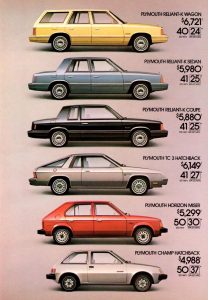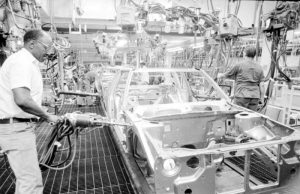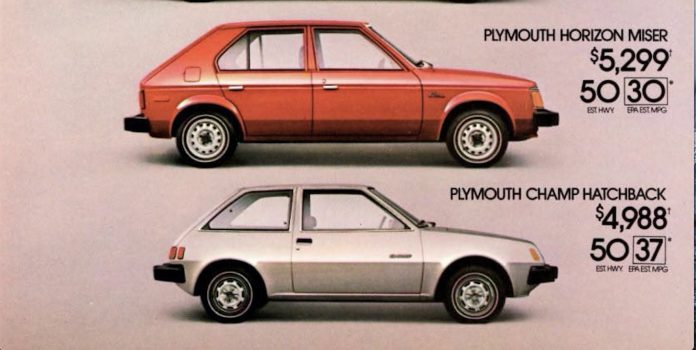Alternative history scenarios make for great story telling – about what might have been.
What if the Confederacy had not allowed itself to be goaded into “firing the first shot” at Fort Sumter – and thereby made it politically difficult for Lincoln to cast the Confederacy as a physical threat to the Northern states?
We might not now live under a consolidated, centralized, super state with practically unlimited power over every state.
Automotively speaking, what if the consolidated, centralized super state with practically unlimited power hadn’t interfered with car design as it has over the past 40 years? What kinds of cars might have been available?
It is possible to extrapolate, based on the kinds of cars that were available 40 years ago, a time when the consolidated, centralized super state with practically unlimited powers barely interfered with car design at all – relative to now.
There were a number of small, lightweight cars that used less gas than today’s small but-not-so-light cars. Among them, the Plymouth Champ, which was a re-badged Mitsubishi Mirage. Either way, this little car achieved 37 MPG in city driving and 50 on the highway – without a computer controlling its engine or electronic injectors delivering its fuel or a modern continuously variable (CVT) automatic transmission.
These are better mileage numbers than the ones posted by modern small but-not-light cars like the new Mitsubishi Mirage, which claims 33 city, 41 highway with the manual transmission; to approach the mileage of the ’80 Champ in a new Mirage – but not equal it – you must buy the extra-cost CVT automatic, which ups the numbers to 36 city and 43 on the highway.
It also costs you $1,300 – just not at the pump. It’s the cost of the price difference between the new Mirage with the manual ($15,295) and the cost of the “more efficient” variant with the CVT automatic ($16,595).
Just for fun, note that $1,300 will buy approximately 500 gallons of gas (at today’s appx. $2.55 per gallon) which would fill up the new Mirage’s 9.2 gallon fuel tank approximately 141 times – which would take you approximately 24,000 miles.
It is interesting to speculate about what the new Mirage’s numbers would be if it were more like the old Mirage/Champ. If it did not weigh about 2,100 pounds – as the new one does – but instead weighed about 1,800 pounds as the old one did. Or – going the other way – if the lighter-weight ’80 Champ had the benefit of computer-controlled electronic fuel injection rather than a mechanical carburetor – and the modern CVT automatic.
As the new one does.
It would probably mean a gain the range of 15-20 percent – whichever way you went – and city mileage closer to 45-50 in the city and highway mileage closer to 60.
Either way, you’d end up with a car capable of using about the same or even less fuel as a current hybrid does – but without the extra cost (and extra weight) of the electric motor/battery pack. The putative purpose of the consolidated, centralized super state with practically unlimited powers’ regime of regulations regarding gas mileage could have been achieved . . . without the consolidated, centralized super state with practically unlimited powers.
A car like the ’80 Champ would also have probably cost us a third to half as much to buy today, were it not for the consolidated, centralized super state with practically unlimited powers – including the power to serially devalue the buying power of money, by conjuring more of it.
In 1980, robotic assembly was in its teething stages; much of the work of putting cars together and of making the parts that went into making cars was still labor intensive. Much more so than it is today. It cost more – in real terms – to make a car like the ’80 Champ 40 years ago than it does to make a car like the new Mirage, today – which is evident in the pricing of both of them.
When it was new, the Champ’s base price was $4,430 – equivalent in today’s inflated dollars to $15,082. Which, as it turns out, is very close to the base price of a new Mirage, which is $15,295.
Bear in mind that the new Mirage is equipped with numerous standard amenities that were extra-cost luxury amenities back in 1980, such as air conditioning, a 140 watt four speaker stereo, cruise control,power windows and locks. If Mitsubishi can sell a loaded – by 1980 standards – new Mirage for the same price that Mitsubishi (via Plymouth) sold a 1980 Champ without any of that, imagine what Mitsubishi could sell a car like the 1980 Champ for today.
With all of that.
It would almost certainly be much less than $15,295 – assuming a car like the ’80 Champ, with amenities of the new Mirage. In part because it would almost certainly cost much less to make the basic car – the 1980 Champ – today than it cost back in 1980 because of more efficient, less labor-intensive manufacturing, which is the main reason a new Mirage with all those amenities can be sold for essentially the same price that Mitsubishi (via Plymouth) sold the ’80 Champ for, without them.
Now imagine what it would not-cost if it didn’t have to be fitted with six airbags – as the new Mirage has. Plus a back-up camera. Nor “comply” with all of the various “mandates” and “standards” – the cost to be paid for by you.
It’d probably have a price tag around $12,000 in today’s dollars – while averaging close to 40-50 MPG.
Were it not for the consolidated, centralized super state with practically unlimited powers.
. . .
Got a question about cars, Libertarian politics – or anything else? Click on the “ask Eric” link and send ’em in!
If you like what you’ve found here please consider supporting EPautos.
We depend on you to keep the wheels turning!
Our donate button is here.
If you prefer not to use PayPal, our mailing address is:
EPautos
721 Hummingbird Lane SE
Copper Hill, VA 24079
PS: Get an EPautos magnet or sticker or coaster in return for a $20 or more one-time donation or a $10 or more monthly recurring donation. (Please be sure to tell us you want a magnet or sticker or coaster – and also, provide an address, so we know where to mail the thing!)
My eBook about car buying (new and used) is also available for your favorite price – free! Click here. If that fails, email me at EPeters952@yahoo.com and I will send you a copy directly!












“Were it not for the consolidated, centralized super state with practically unlimited powers.”
That, and if it weren’t for the dildos demanding an automated smartphone on wheels. Apparently, they can’t even be bothered to turning a damned key anymore!
What if the Confederacy had not been goaded into firing the first shot at Fort Sumpter?
Heavens to Betsy, Eric, time to tell the true tale of what happened…. In 1995 my wife and I rode our motorcyle from Pittsburgh to Charleston, S.C. Of course we took the official tour of the town. Our guide and proud historian was an 80 year-old Grande Dame of The Daughters of the Confederacy, who set the record straight on what really went down that fateful day…..”Everyone says the South fired the first shot at Fort Sumpter, but it was you Yankees who did that! Don’t believe what you read in the history books.” How could we possibly argue with Grandma…..
Hi John,
Many scenarios – which is part of what makes alternative history so interesting! I think there is an important psychological – as well as marketing – as well as military – aspect to “firing the first shot.” In the case of Sumter, had it been my call, I’d have announced the Yankees were free to depart and facilitated that in any way possible. But no attack. Let the Yankees be seen as the aggressors. Then defend. The South was in a poor position to attack much of anything, being in lack of men, material and transport. Why not pull a Giap and let the North exhaust its men, material and so on by launching a war of aggression against people who simply sought self-determination? How long could Abe have maintained the necessary public support? The South is a large area. Bleed the Yankees…
Yeah. Let’s see….1865 to 1995 and Grandma still had a political axe to grind 130 years after the war. I ‘m not sure us “Yankees” would have wanted to visit her on an overnight stay. (heh heh)
Damn the consolidated, centralized super state with practically unlimited powers!
” $1,300 will buy approximately 500 gallons of gas (at today’s appx. $2.55 per gallon) which would fill up the new Mirage’s 9.2 gallon fuel tank approximately 141 times – which would take you approximately 44,000 miles”
500 gallons / 9.2 gallons in a tank = 54.3 tanks
“37 MPG in city driving and 50 on the highway”
500 gallons * 37 = 18,500 miles
500 gallons * 50 = 25,000 miles
(I enjoy all your articles, eric. Thanks for all your work exposing the enemies of freedom.)
Eric – many moons ago, I had TWO Plymouth Champs in succession. One was a ’82, with the automatic, had a cherry interior. One day, however, on a family trip, the engine crumped (blown head gasket, spun bearing), so quickly found an ’80 with the “Twin Stick” for cheap which at least had a solid engine and drive train, but interior was ratty. Put my kids to work helping me to transfer sheet metal, upholstery, body panels, and so on, but they being little fit a lot better for that work than I did! Plus, gave them all interest which has carried over 30 years later, as all to some extent do their own work on their rides. The ’80 with the Twin Stick could go all the way from Sac town to Disneyland on a single tank (it did three times). Did a lot of pizza schlepping on the side with it too. Why did I ever let that car get away?
As for the Battle of Fort Sumter, UNAVOIDABLE. Eric. South Carolina, which had thirty years previously gone through the “Nullification Crisis”, led off by declaring secession on Dec 20, 1860, as soon as news came of Lincoln being formally elected POTUS by the Electoral College. As each Southern state that joined the Confederacy seceded in turn (the actual existence of the Confederacy is believed to begin with the Montgomery Convention which picked a provisional national government and elected Jefferson Davis as its President on Feb 8, 1861), it was a matter of said states mobilizing their militias to evict US Government installations, particularly US Army forts, like Sumter. Some were voluntarily withdraw as their respective positions were untenable; but Lincoln directly ordered the commandant of Sumter to hold out until reinforcements arrived. It was when Confederate sympathizers in Virginia got word that the Navy was sailing for Charleston when the hastily assembled “Confederate” forces under PGT Beauregard opened fire on Fort Sumter on April 12, 1861, and forced its surrender the following day. Had the US Navy been able to reinforce Sumter, a blockade of Charleston would have immediately ensued, followed up by the same action at other Confederate ports like Savannah, Mobile, Pascagoula, New Orleans, and Galveston, and the Confederacy likely would have quickly collapsed. Indeed, Virginia, over which secessionism was not popular everywhere, may have remained in the Union, and Robert E Lee may well have taken command of the newly formed US Army of the Potomac!
A while back I got interested in GMC RVs, AKA the EM-50 from the movie Stripes. They are pretty amazing vehicles, even today. The carbureted Olds 455 could get about 10-12 MPG on the 26 footer, at least in 1973. No idea what sort of hit the milage took with the addition of catalytic converters and unleaded fuel starting in ’75, but probably wasn’t pretty. My dream would be to get a pre-75 one, and put on fuel injection, turbo, high flow exhaust, and an overdrive final with the goal of getting it up to 20 MPG empty and a 0-60 time of “pretty good, considering.” Or just do an LS swap and be done with it, although that’s probably a mortal sin…
Those Em-50’s are very cool. Probably could sell today. No offense but I doubt you’d ever get near 20mpg. mpg is mostly about weight first and secondly, aero at speed. Guessing this thing weighed about 8-10K?
For perspective my ram weighs around 5K with a modern v8 and some little aero tricks and it can’t get even close to 20mpg unless ya have a 30mph tailwind, haha….
If you have an instant mpg screen on your car take a look how it does going up hills, then down., or accelerating. Gotta move that mass. Takes power, and more of it the heavier it weighs.
I had a fairly modern RV diesel a while ago and it was around 8 if you wanted to go slow.
My dad did a GM 6.2 diesel swap into a very similar motorhome (size, weight, streamlining) and we got a solid 16mpg on mostly level ground. And it really wasn’t much more underpowered than the rod knocking 350 it replaced.
I routinely get 15 with my 01 RAM2500 Cummins while towing a 24 foot gooseneck with a high toolbox on the neck (lots of air drag) and a couple thousand pounds of car on it.
If you want MPG in a big/heavy vehicle, diesel is THE way.
That’s impressive. I have not seen similar numbers. maybe cause i like to go faster than most? my rv had a very flat nose though. 10mpg if you babied it, was about 20K lbs with a CAT.
Yeah, I do drive like I have something to hide…
Hey Eric,
My earliest friend (we’ve been friends since 3rd grade) had a Plymouth Champ. It had, effectively, an 8 sp manual transmission. It had a normal 4 sp stick shift but, to the left of the shifter, it had a smaller shifter that could increase or decrease the gear ratio in between the large changes from the main shifter. It was pretty cool.
Cheers,
Jeremy
I learned to drive on a Dodge Omni with a 4 speed stick and an FM radio, which was probably the only option ordered. My sister, being 3 years older than I, learned on the Dodge Colt, which had that same “power/economy” shift leaver your friend’s had. The Colt was so light my sister’s male friends once picked it up (in an attempt to pick her up I’m sure). Fun cars, but complete shitboxes compared to the 70s cars most of my classmates inherited after their granddad died of lung cancer (my grandparents somehow dodged that bullet).
Hi Dan,
“Another example of the incompetence of govt central planning”
Why do you use “incompetence” to describe this?
I don’t see any incompetence.
I’d say it is the opposite.
What is the goal or philosophy of Govco?
To tax and spend, right?
How can Govco continue to tax and spend if the stated goal was actually achieved?
Have you ever noticed that when the stated goal is NOT achieved, the solution is ALWAYS more laws, more taxing, and more spending? ALWAYS.
What do you know about automobile emissions?
One of the very first stated goals was to reduce pollution caused by cars. Right?
How was this achieved?
I learned firsthand when I was 10 or so. Carol Shelby was in our plant explaining the mandates to my dad and his brother.
That old chicken farmer gave an explanation that everyone in the plant could understand. Even a young child.
So the stated goal was to reduce pollution. This was “achieved” by pumping clean air into the exhaust system of the car using an air pump bolted on to the engine.
This did indeed reduce the amount of pollutants as measured at the tailpipe. The clean air diluted the exhaust.
I didn’t know what dilution was back then but Mr. Shelby asked me what happens to the color of pee when it goes in the toilet bowl. That I understood. Just like mixing pee with water when you mix air with smoke it isn’t as dark.
The air pump requires energy. That energy comes at a cost.
The car now got less miles per gallon. So it burned more gas and exhausted more pollutants.
Ergo, the stated goal of reducing pollution, in reality caused more pollution.
Would you call that incompetence? Or do you think that maybe, just maybe, the people mandating those air pumps knew that the end result of more pollution would give them the excuse to decree more mandates further on down the line?
My money is on the latter.
The gov’ts appearance of stupidity is cover for its malevolence.
Anon,
“The gov’ts appearance of stupidity is cover for its malevolence.”
Why is it that no one gets the punchline when the joke is repeated as often as it is?
There is no excuse. Once upon a time everyone joked about the incompetence of gov’t. That was the plan, I suppose, make everyone think it’s a joke, then shrug and move on….meanwhile, the wheels of gov’t continue to turn, crushing our liberties.
Hi Tuan,
Your post reminded me of this,
https://blog.independent.org/2013/09/13/all-government-policies-succeed-in-the-long-run/
from the great Robert Higgs.
“People label a policy as a failure because it does not bring about its declared objective. For example, drug policies do not reduce drug use; educational policies do not educate children better; national-security policies do not make Americans more secure; and so forth. The mistake is to take seriously the announced policy objectives, to forget that virtually everything the government does is a fraud. The best way to document the government’s nearly unblemished record of policy success is to follow the money. With very little trouble, you will be able to follow the trail to the individuals and groups who benefit from the policy. Occasionally the true beneficiaries do not benefit in the form of augmented income or wealth, but in other forms of reward, yet the principle remains the same.”
Cheers,
Jeremy
Jeremy,
Why is it that Higgs is ignored or dismissed?
I’ll admit I voted for Mr. government is the problem Reagan. But after exacerbating the problem for 8 years, I knew the Trumpster was going to accomplish what Ronnie did in half the time.
I haven’t checked the numbers but I think Trump expanded Govco even more than the Ray Gun did.
Am I wrong?
Hey Tuan,
Probably because he eviscerated the “war/government spending got us out of the depression” myth that poisons mainstream economics to this day. Also, his “ratchet effect” theory that exposes the fraud of “limited government”. Finally, there’s this, “The State is too Dangerous to Tolerate”, an absolute tour de force, a kind of “Anatomy of the State” on steroids.
https://www.youtube.com/watch?v=RILDjo4EXV8
Pretty sure you’re right about Trump as well.
Cheers,
Jeremy
Jeremy,
You mentioned mainstream economics.
Perhaps you’d be kind enough to refresh my memory.
If I break out your windows, do you benefit? Do I benefit? Or is it only the glaziers who benefit?
Hey T,
“If I break out your windows, do you benefit? Do I benefit? Or is it only the glaziers who benefit?”
C’mon, we all benefit,…in the abstract.
Cheers,
Jeremy
I apply Halon’s razor to govt. Never attribute to malice that which is adequately explained by stupidity.
Based on my experience with the govt, they are not a repository of the best America has to offer.
There are definitely malicious actors among them, but laziness is the guiding principle.
If almost everything and organization does turns out to have zero to the opposite effect of the stated intent, I find it more likely policy is created by those who have trouble tying their shoes vs a conglomerate of Machiavellians.
They are counting on you and others like you to feel that way. Keeps the inertia going, stifling resistance to the open and obvious evil that has been pushed upon all of us.
I have owned two of the cars in that second MoPar ad (Aries wagon, Turismo) and loved them. Owned one for 22 years until the rust from 3 NY state winters finally et the A-pillars out from the inside. I have driven a third (Champ) and loved it, too, especially that Twin Stick 4-speed manual with dual ranges. No turbos, only TBI on the Aries, simple, light, handled well, really good fuel economy.
Yes, Unca Sammy sticking his gigantic schnozz into car engineering has been a disaster, both for the cars themselves, and for our freedom. Folks south of the border could buy dual-port 1.6L Beetles brand new for something like $8K in dollarettes up to about 20 years ago, and the last had Bosch EFI even! Why should I not have that choice available?
I had a 78 Honda Civic that did that kind of mpg. Probably more.
Bought it for $250 in 1988 drove it for a year with what turns out was 3 cylinders. Cost me 150 or so to the machine shop to rebuild the head, another 40 in gaskets, and it ran like a sewing machine.
Guts as simple as a butter churn too. Manual tranny, manual choke.
Great car. All rusty and shitty, I could park it anywhere and leave it unlocked.
Or what might have been if instead of the troops enforcing a tax under the command of Geo Washington, they took him into custody, marched back to the capital, and put him and Hamilton up against the wall.
Every single government has exactly one basic premise. That it, and it alone has authority to kill you if you don’t comply. Death is its coin. Which is why there never has been, and never will be any such thing as “good government” unless we govern ourselves.
‘Death is its coin.’ — John Kable
That’s why, in the cryptocurrency era, the US dollar is now described as a ‘proof of guns stablecoin.’
Red-in-tooth-and-claw leftists are fine with enforcing the use of state-backed fiat currency at the end of a rifle barrel, even as its disastrous overissue sparked an eye-popping 9.8% explosion in retail sales just last month.
Get ready for the Biden Summer of free money, free beer and free love. Like the trippy summer of 1967 in San Francisco, it’ll be all downhill from there, as the sad lesson that Big Gov can’t print prosperity is painfully learned all over again.
In the matter of the Whiskey Rebellion, John, you might almost say it was an intra-Keystone State thing. At the time, the national capital was in Philadelphia, with the fledgling US Government occupying rented quarters, with, revenues as spotty as they we, often Washington had to come up with the rent out of his own pocket. Certainly Philly folk were all happy with having the temporary capital there, and many would have made it permanent. But there were a whole bunch who’d settled the “frontier” of the time, this being only a generation removed from when Washington, as a young Captain in the VA Colonial Militia, at first was sent as an emissary to politely admonish the French to abandon Fort Duquesne (present-day Pittsburgh, PA), and later returned with militia. Most of these “rustics” had little use for ANY government, period. Another thing that’s often forgotten is that most Americans were farmers, and most farmers had little use for currency. One COULD keep a stash of gold or silver coins, but, of course, they were subject to theft or robbery. Largely the early US economy was barter-based, with the key items being those that were the most portable and valuable; i.e., livestock and/or LIQUOR. Though certainly Americans, being mostly from British or German stock (and well into the 19th century, many spoke a German dialect, often “Plattdeutsch” as their primary tongue), drank a lot of ales and beers (almost every town had a brewery, and often “homebrew” was what most folks were accustomed to), but, being bulky and heavy, and this being the days before refrigeration and the automobile, they didn’t make good “currency”. Distilled Spirits, OTOH, were compact, didn’t require any further preservation, and therefore served as de facto currency in frontier American. Hence why the rustic folk of western PA, and this long before the legendary Pittsburgh Steeler fans and their “terrible towels”, resisted any attempts at taxation, it directly impacted their very livelihood!
Hence we had already the divisions within American culture, the “city folks” of Boston, New York, Philadelphia, and later, as it grew, Washington, being more supportive of the large central Government, which got its revenue from mainly two sources: tariffs and excise taxes, the latter being most liquor taxes. That’s exactly what the rural, rustic folks, especially in the Appalachians, didn’t care for, them “city folks” living off THEIR efforts in just making a little “cawn likker”!
Info like this makes my head hurt.
We used to have the very thing that they now want, but made impossible to have.
Another example of the incompetence of govt central planning